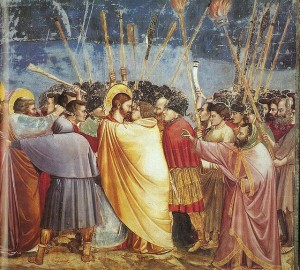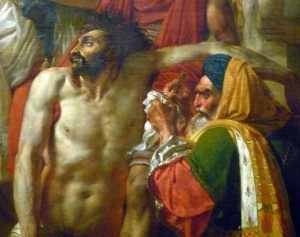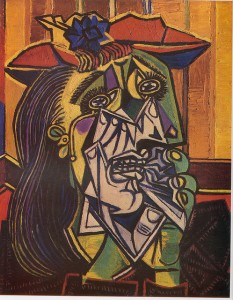Art has always been society’s outlet for expressing culture. Whether used as a means of personal expression, symbolism of a movement, a call for change, or simply a method incorporating new ideas, artists of Europe have been revolutionary for centuries.
-Andrew Steck
[slider imgs=14,15,16,17,19]
Renaissance:
Featuring the artists Leonardo Da Vinci, Raphael, and Michelangelo, this period is one of the earliest revolutionary movements for the the world of art.
Established shortly after the middle ages, and extending into the late 1500’s Renaissance period art was considered revolutionary because of its renewal of Greco-Roman ideas (History.com Staff, 2010). The period produced very famous artists out of Italy, who were well known for their thematic content that also sought to capture a beauty and individuality (Albertini), as can be seen in Da Vinci’s Mona Lisa. The primary revolutionary force in art came out of Italy, where artists began many of their perspective and emotion based painting innovations, capturing human emotion and inventiveness (Albertini) and incorporating new perspectives such as landscape paintings and metal relief sculptures (Beck, 2000).

Mona Lisa
by J. Kleeman, used under 
An especially notable figure when it comes to Renaissance art is the Italian painter Giotto di Bondone. Living from c.1266-1337, Giotto was renowned for perpetuating the revolutionary Renaissance art culture and respected for his in depth depiction of human emotion. Some even regard him as the father of the Renaissance (Artable, 2014). His artwork is widely respected today, and is speculated to have been in cathedrals in Assisi, Rome, Padua, Florence and Naples, however it is unable to be confirmed (History.com Staff, 2010).

Kiss of Judas * Giotto di Bondone
by Carla217 , used under 
Art of the period was drastically effected and influenced by the events and authority of the time, including plague, war, and religious authority (History.com Staff, 2010).
Innovations and lasting revolutions of this period include oil paint, metal relief sculpture, and concept of aerial perspective (Beck, 2000).
Romantic:
“Romanticism is precisely situated neither in choice of subject nor in exact truth, but in a way of feeling.”
-Charles Baudelaire, 1846 (Galitz, 2000)
Romanticism was a period in art culture born out of the French Revolution. Roughly time-lined are 1800, this art movement was in response to themes of the enlightenment. In the artistic revolution that it caused, “nature—with its uncontrollable power, unpredictability, and potential for cataclysmic extremes—offered an alternative to the ordered world of Enlightenment thought. (Galitz, 2000)”
Notable Artists of the Romantic period responded to the wealth of order and information found in Europe’s enlightenment period, and asserted the beauty and formidable powers of nature to revolutionize the art culture. These artists such as, Baron Antoine-Jean Gros, Anne-Louis Girodet-Trioson, Jean-Auguste-Dominique Ingres, and Eugène Delacroix, were notable students of neoclassicist painter Jacques Louis David. As a direct opponent to the Romantic style, a series of paintings of Napolean conquests “had something in common with Romantic painting, although he always remained opposed to the Romantic school ,” and these led to further development of the Romantic timeline through his famed students. (Pioch, 2002).

Gros, Napoleon Bonaparte Visiting the Plague-Stricken in Jaffa with detail of nude
by Steven Zucker, used under 
For more images of Romantic Period Art, please click here!
Modern:
Modernism was an artistic movement that took ideas and concepts from the European enlightenment, breaking away from the power of nature and focusing on the power of individual creativity and genius in the creation. The mid 1800s invention of the camera helped to further the creative possibility of the artist (artsconnected).
While this movement is by no means exclusive to the Culture of Europe, many European artists have contributed to this movement. View their works here!
With that said, arguably the most influential Modernist, Pablo Picasso, was born on October 25, 1881, in Málaga, Spain and died April 8, 1973, Mougins, France, and worked most of his life in Europe. Picasso spent many years of his art producing career in France, specifically Paris and Avignon, and went through several distinct periods of his own art (McCully). Picasso’s art is widely regarded as revolutionary for the time, as he took the ideals of modernism and used his artistic talents to make them extremely memorable through his use of “the ‘re-presentation’ of the form of objects and their position in space instead of their imitation through illusionistic means..” (McCully).

Pablo Picasso-Cubism 1937
by Ian Burt, used under 
Pablo Picasso-Cubism 1937 (Burt, Picasso – Cubism 1937)
Contemporary and Postmodern:
Contemporary and Postmodern art is a recent movement in the scheme of history that began after WWII. “Postmodernism pulls away from the modern focus on originality, and the work is deliberately impersonal (Gambino, 2011).”
An essence of eclectic nature, and creative use is a primary focus, with prominent artists from all over using creative methods to remove personal touch, or creative means to add unpredictability to their creation and still expressing their thought or idea (Gambino, 2011). Some even consider the movement to be a revolutionary reaction against the modernism movement that preceded it (Goldner).
The current postmodern art can be broken down into many sub-genres, including:
- Conceptualism
- Graffiti Art
- Neo Expressionism
- Installation
- Minimalism
- Neo Pop Art
- Performance
- Photo Realism
- Video and Animation
(Goldner)
Interested in more information on European Art?
Watch this Video tour of the Lourve!
Art Citations:
Albertini, T. (n.d.). Renaissance Italian Aesthetics. Oxford Art Online. Retrieved Afrom http://www.oxfordartonline.com/subscriber/article/opr/t234/e0440#0195113071.renaissance-italian.2.jpg
Artable. (2014). Giotto di bondone. Retrieved from http://www.artble.com/artists/giotto_di_bondone
Artsconnected. (n.d.). Modern and postmodern art. Retrieved from http://www.artsconnected.org/collection/142161/modern-and-postmodern-art?print=true
Beck, J. H. (2000). Renaissance art and architecture. Retrieved from http://autocww.colorado.edu/~flc/E64ContentFiles/PeriodsAndStyles/Renaissance.html
Galitz, K. C. (2000). Heilbrunn timeline of art history. Retrieved from http://www.metmuseum.org/toah/hd/roma/hd_roma.htm
Gambino, M. (2011, September 23). Ask an expert: What is the difference between modern and postmodern art? . Retrieved from http://www.smithsonianmag.com/arts-culture/ask-an-expert-what-is-the-difference-between-modern-and-postmodern-art-87883230/?no-ist
Goldner, L. (n.d.). Deconstructing postmodern art. Retrieved from http://www.contemporary-art-dialogue.com/postmodern-art.html
History.com Staff. (2010). Renaissance art. Retrieved from http://www.history.com/topics/renaissance-art
McCully, M. (n.d.). Encyclopedia britannic-pablo picasso. Retrieved from http://www.britannica.com/EBchecked/topic/459275/Pablo-Picasso
Pioch, N. (2002, 7 14). David, jacques louis. Retrieved from http://www.ibiblio.org/wm/paint/auth/david/
Photo Citations:
Burt, I. (Photographer). Picasso – Cubism 1937 [Web Photo]. Retrieved from https://www.flickr.com/photos/oddsock/101164507/in/photolist-534wS-b6Jcb4-ehk1nx-bZJHBb-bZJHtd-4bdtvN-9WuFD-9reSki-8BNKHY-8BNKDY-8BNNDQ-8jBzRX-6krekr-LuzB-hwMLFZ-4oYdP4-c2wZd-8BKDRH-8BNKpN-4bdtv5-dVd6fR-3h8A1-3h8ii-cgtRmb-9M2Fpw-9XgGPt-9XgNQn-8BKDdP-5DpLMw-79wAg-8BNJQE-5RW3Mt-Abyw-5XMWrx-2mPXxD-8MWn1C-64Xdcw-64XcHC-3h8Gu-3h8te-3h89K-cgrUQJ-8HqaeU-aYUhFt-38aUoS-aYUgSH-c52Z45-8MvLpF-q6PPf-2rdnq
Carla216. (Photographer). (2008, 02 9). Kiss of Judas * Giotto di Bondone [Web Photo]. Retrieved from https://www.flickr.com/photos/hauntedpalace/2252817977/in/photolist-4r5hig-efXkif-efzmhu-cFZ4D7-evAMXo-e7Kiae-evLxjs-evxEtK-evBtdL-evAMJJ-evAMMh-evLxib-evxEmR-evykFZ-evxEkv-evLxpW-evLxmh-evHp3z-ex1mU5-exQpnS-exMe6n-ewXbNv-ewXbRt-exQpih-ewXc8Z-ex1nrL-ex1n8w-ewWGpD-ewZSQd-ewXbWt-ex1nfU-ewXc5c-ewZSyA-ewZSC7-ewZSJy-ewXbVv-e7LnMz-e7RDT1-exMe9X-ewWGFe-ewZSWd-ewZSUb-ewWGJD-exRds1-e6aAQf-e7Ki98-6CbmvA-6C7aA4-6CbjYS-6Cbhhh
Kleeman, J. (Photographer). Mona Lisa [Web Photo]. Retrieved from https://www.flickr.com/photos/jkleeman/4129461743/in/photolist-8oFaXe-bwk1Bj-9zHeFo-7hUz7g-6Cvtfg-8T7hfe-4cRvkR-aNq36x-8xRJ9a-gEcw1-8ai3zQ-BsqL-8idKTf-4AbuC9-8a8uRw-fJpvf6-wzay-2V4jgj-9NHcFk-2Kx9v-8ifkWX-2Kx8Y-bnTLxV-swdyd-7ZcDHg-egxiCK-68eDuF-97TB8E-boaP5T-5dZLXd-2Uby9-78bj4K-ayySZZ-2umSRR-i9f1aF-5mdWBh-7fafYC-6zj8rJ-2rChaP-4iG4Xv-6YhDxv-UgA8E-8TXwVB-ta8K8-5bLg3-a3i51s-7vxkbt-6HGo4p-9FKie5-72v
Santos, T. (Photographer). Leonardo da Vinci – Ginevra de’ Benci (1474) [Web Photo]. Retrieved from https://www.flickr.com/photos/thsant/410678134/in/photolist-5cKqxC-7Zuqwc-7ZxFWJ-7ZxvVA-7ZuHge-7ZxpBC-7ZxnPA-8nn2i2-8nq7Ru-8nq94N-ChQiu-dsD5SQ-4QW7ve-7DWRQq-5jWVt-a5REbP-a5RE8n-a5REaD-a5Uv51-4qLcG7-frVBTH-7a1f8L-fsaTcY-frVy9F-8nn2Fz-8nn12e-cBQSEj-fi4Roy-fhPyQR-fhPxXV-fhPKW6-fhPK6p-fi4ZFW-fi53zm-fi4YEd-fhPP2g-fhPwWv-fhPRvV-7a6pAq-8nn1pF-bCGJgu-XksNy-fsaYEU-XksLd-fsaVEE-7DT33X-7DWRTu-cBQZps-7RCnTg-fsaRXu/
Zucker, S. (Photographer). Gros, Napoleon Bonaparte Visiting the Plague-Stricken in Jaffa with detail of nude [Web Photo]. Retrieved from https://www.flickr.com/photos/profzucker/5802888840/in/photolist-9QMj6L-9QJt4g-9QMkd7-9QMn3s-9QMjFA-9QMkZy-9QMkrf-9QJuWa-9QMjU3-9QMmzC-9QMkC5-7NRJf6-66Zqos-fupjSX-3grr6L-eGtQkN-9H2aQw-a2dD5A